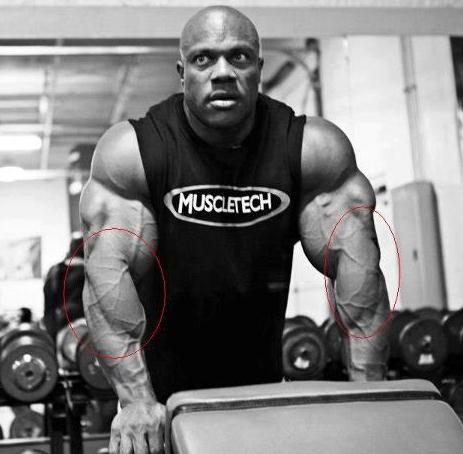The brachioradialis is located at the upper outer region of the forearm and should not be confused with the brachialis, the latter being an upper arm muscle. Perhaps the best bodybuilder to use as anatomy chart to display the brachioradialis is Mr. Olympia Phil Heath who is “gifted” with one of the most impressive pair in the history of pro bodybuilding.
The brachioradialis is an elbow flexor muscle and is used when using a palms down or overhand (pronated) grip. Therefore, exercises that flex the elbow while using an overhand grip will recruit and stimulate the brachioradialis. It is interesting to note that the brachioradialis has more or less the same muscle fibre composition as the biceps, meaning a good amount of type II (fast) fibres compared to other muscles of the forearms which have more type I (slow) fibres. This allowance of type II fibres in the brachioradialis has important implications for understanding the function and what repetition range to use to effectively train this muscle.
 Muscular anatomy of the forearm
Top and bottom pictures show the inner and outer forearm respectively
Muscular anatomy of the forearm
Top and bottom pictures show the inner and outer forearm respectively
Flexing the elbows using an overhand grip puts the biceps in a mechanically weak position. Just imagine how stronger you are in an underhand grip barbell row or lat pulldown compared to when an overhand grip is used. Therefore, elbow flexion movements using an overhand grip bring the brachioradialis into play to assist the biceps. This explains why the brachioradialis has a good percentage of type II muscle fibres just like the biceps.
EXERCISES AND REPETITION RANGES
As mentioned above, exercises that involve elbow flexion with a palms down grip work the brachioradialis as a secondary muscle. These include overhand grip rowing and pull-up movements. Good exercises are T-bar rows, rows and chinups/ pullups. Recommended repetition range is 6-12. I personally like to follow my back workouts with a forearm workout comprising of an isolation movement for the brachialis like reverse barbell curls.
OTHER EXERCISES
1. Reverse barbell curls: reverse barbell curls can be done standing and seated on a preacher curl bench. Some trainees find that using an overhand grip with a straight bar can be uncomfortable on the wrists and therefore use a cambered (EZ) barbell. Generally a shoulder width grip is recommended. As a personal tip for this exercise I recommend keeping the wrists fixed throughout the movement instead of moving them. I find that this taxes the brachioradialis muscle even more. Elbows should also be fixed and the weight should be appropriate in order to avoid recruiting assisting muscles excessively.
2. Hammer curls: use of a hammer grip also works the brachioradialis and involve a lot of brachialis at the same time. Hammer curls can be performed using a preacher bench, using rope or dumbbells. In the latter case, there are two variations, namely the conventional hammer curls and the cross body or “pinwheel” variation pictured below. Because this exercise also works the brachialis I recommend doing it on biceps day but can be included as best fits your program.
3. Zottman Curls: this is an old school exercise which is hardly ever used nowadays. In this curl you start with a biceps curl with palms facing up. At the top of the movement rotate your wrists so that the palms are now facing downwards (pronated). Perform the negative part of the curl using a pronated grip. This exercise therefore works both the biceps and the brachioradialis. Elbows should be kept stationary at all times and not depart from the sides of your body. The exercise can be done in an alternate manner as well.
4. Close grip pronated grip pullups: this exercise will leave you in serious pain but can produce dramatic results. Go under a smith machine bar set at about waist height and using a close and pronated grip (elbows tucked to the side) bring your body up towards the bar. Hold it there.
by Vic Veeraj Goyaram (africanmuscle)



Post your comment